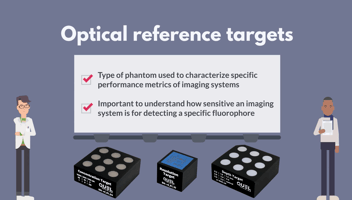A Look at Optical Reference Targets For developers and users of fluorescence imaging systems,...
Save a pig, use a phantom
This past spring we participated the NIH I-Corps program. As part of this program we interviewed 100 potential customers and stakeholders working on the clinical translation of optical imaging technologies, mainly fluorescence guided surgery. We spoke to people from a range of backgrounds from graduate students to surgeons and plenty of teams developing the next generation of fluorescence imaging systems. From these conversations we identified a number of themes, including the role of optical phantoms in the process of clinical translation.
As a grad student at the Dartmouth Center for Imaging Medicine, I was familiar with using meat to test system sensitivity for different fluorescence contrast agents. The fluorophore under test would be injected into or placed under thin cuts of meat to simulate imaging in human tissue. It was common for students to go to the local food co-op and buy fresh chicken breast or pork chops for these experiments. Occasionally, we’d even see a fancy cut of steak in the laboratory refrigerator and wonder what experiment it was for. We often joked we couldn’t afford to eat the meat we were buying for these experiments, and I have a feeling some special cuts may have disappeared at the end of the day...
So during our interviews it was reassuring (or maybe a little concerning?) to find other groups doing the same thing. This isn’t a grad school trick, this is used across the industry. Development teams reported making friends with their local butcher and going on late night runs to the nearest grocery store to buy meats for their experiments. Thin slices of bacon placed over fluorophore serial dilutions is a simple test for depth sensitivity, but I wonder what the deli attendant was thinking when asked, “I’d like a ½lb of bacon cut exactly 2mm thick” ?
These methods are used widely in the field, and they can be an effective method for demonstrating system performance, but they suffer from problems with reproducibility. We founded QUEL Imaging to address these problems and more. We’re working with the field to identify issues like this and develop sustainable commercial solutions to advance the field based on a foundation of science. Our goal is to work with our customers to identify ways to characterize system performance to accelerate the clinical translation of fluorescence imaging systems. So when you’re planning your next experiment, save a pig and use a phantom.




